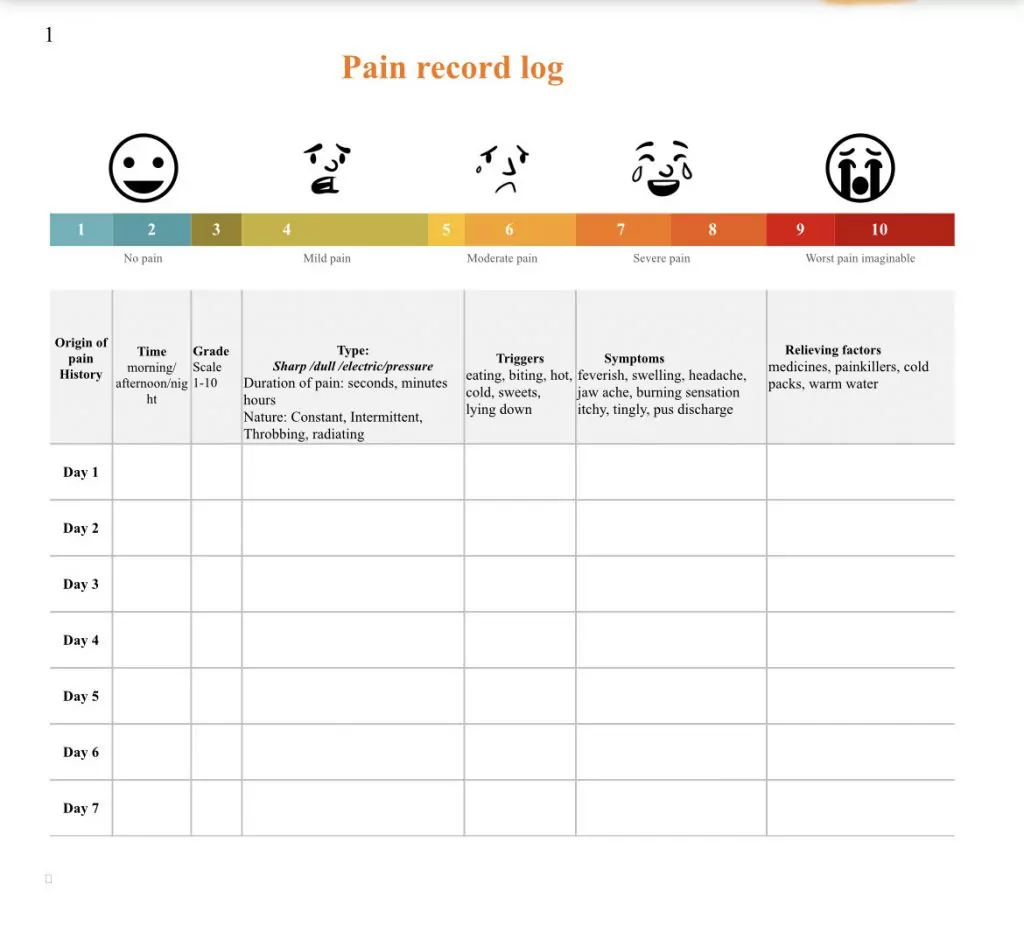Struggling to communicate your dental pain effectively to your dentist? You’re not alone. Describing pain can be challenging, often leading to miscommunication and delayed treatment. But fear not! There’s a powerful tool at your disposal: a dental pain log.
This simple yet effective strategy helps you document your pain in detail, empowering you to share valuable information with your dentist. This, in turn, leads to improved communication, accurate diagnosis, and ultimately, a faster path to a pain-free smile.

Why is a Dental Pain Log Important?
- Improved Communication: Describing pain accurately can be challenging, especially when it’s radiating or throbbing. A pain log provides a detailed record of your pain, including its location, intensity, duration, and any triggers or relieving factors. This information allows your dentist to understand your pain better and make informed decisions regarding your treatment.
- Accurate Diagnosis: Dental pain can have various causes, ranging from cavities and gum disease to cracked teeth and sinusitis. A pain log helps your dentist identify the source of your pain by pinpointing its specific characteristics and timeline. This information is crucial for reaching a definitive diagnosis and determining the most appropriate treatment plan.
- Treatment Monitoring: By tracking your pain over time, you can assess the effectiveness of your treatment. Is your pain decreasing in intensity? How long does the pain relief last? Recording your observations helps your dentist adjust your treatment plan as needed and ensure optimal pain management.
- Increased Confidence: Keeping a pain log empowers you to take an active role in your dental care. By gathering and sharing information, you can feel more confident and informed about your treatment, leading to better communication and collaboration with your dentist.

What to Include in Your Dental Pain Log:
- Date and Time: When did the pain start? Has it been constant or intermittent?
- Location: Where is the pain? Is it localized in one tooth or spread across several?
- Intensity: Rate the pain on a scale of 1 to 10, with 1 being barely noticeable and 10 being excruciating.
- Duration: How long does the pain last? Does it come and go, or is it constant?
- Character: Describe the pain. Is it sharp, throbbing, dull, or aching?
- Triggers: What seems to bring on the pain? Is it certain foods, drinks, temperatures, or activities?
- Relieving Factors: What helps alleviate the pain? Are there any medications or home remedies that provide relief?
- Additional Observations: Note any other symptoms you may be experiencing, such as swelling, sensitivity, or bleeding.

Tips for Keeping a Dental Pain Log:
- Start immediately: Don’t wait until your next dental appointment. Begin logging your pain as soon as it starts.
- Be specific: The more details you provide, the better your dentist can understand your pain.
- Be consistent: Record your pain regularly, even if it seems mild or intermittent.
- Bring it to your appointment: Share your pain log with your dentist at your next visit.
- Update regularly: Continue updating your log even after your treatment starts to monitor its effectiveness.
External Resources:
For additional information and resources on dental pain and pain logging, you can explore these helpful websites:
- The American Dental Association: https://www.ada.org/en/resources/research/science-and-research-institute/evidence-based-dental-research/pain-management-guideline
- The National Institute of Dental and Craniofacial Research: https://www.nidcr.nih.gov/
- The Mayo Clinic: https://www.mayoclinic.org/first-aid/first-aid-toothache/basics/art-20056628
By actively participating in your dental care through a dental pain log, you can achieve effective communication with your dentist, leading to a more accurate diagnosis, efficient treatment, and ultimately, a healthier, happier smile.
Conclusion:
By keeping a dental pain log, you can become a valuable partner in your dental care. This simple yet powerful tool can help you communicate your pain effectively, leading to a faster diagnosis, more effective treatment, and ultimately, a brighter smile.
Remember, good communication is key to successful dental care. So, take advantage of this valuable tool and give yourself the gift of a pain-free smile.







